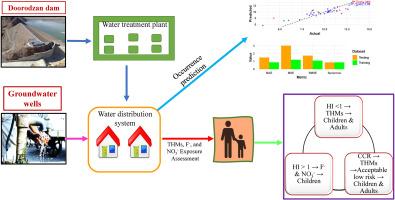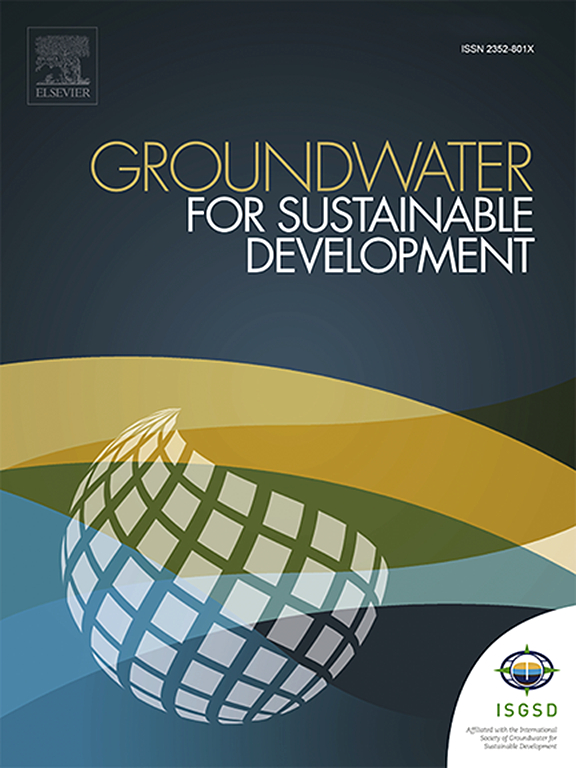氯化饮用水中的三卤甲烷:伊朗南部的季节变化和健康风险评估
IF 4.9
Q2 ENGINEERING, ENVIRONMENTAL
引用次数: 0
摘要
三卤甲烷是最危险的消毒副产品,评估其不利影响对保护社区健康至关重要。本研究评估了理化参数、三卤甲烷含量、对其的预测以及使用概率和索博尔分析法进行的风险评估。结果表明,电导率、溶解性总固体、硝酸盐、硫酸盐、钙、锂、有机碳总量和铵超过了允许限值。三溴甲烷(冬季为 0.14-3.21 μg/L;夏季为 0.06-0.17 μg/L)、三氯甲烷(冬季为 1.90-3.53 μg/L;夏季为 3.19-5.44 μg/L)、溴二氯甲烷(冬季为 0.冬季为 62-4.24 μg/L;夏季为 3.27-6.41 μg/L)和二溴氯甲烷(冬季为 0.82-2.41 μg/L;夏季为 0.69-3.03 μg/L)仍在安全范围内。随机森林分析确定总有机碳是三卤甲烷产生的最重要因素,三卤甲烷与溴之间呈正相关。根据世界卫生组织的风险评估,三卤甲烷的浓度不会对居民造成伤害(IWHO<1)。不过,美国环境保护局的评估表明,癌症风险较低(所有群体的累积癌症风险为 100%),可以接受。此外,硝酸盐和氟化物水平超过了标准限值,居民在这两个季节的危害指数都超过了 1。蒙特卡罗模拟显示,第 95 百分位数的居民面临非致癌风险(硝酸盐和氟化物)。然而,100% 的儿童和 99.98% 的成年人暴露于三卤甲烷的可接受低致癌风险中。吸入率、体重和三卤甲烷水平等因素对健康风险有重大影响。这些发现凸显了持续监测和有效水处理对保障公众健康、促进清洁水和推动可持续发展的必要性,倡导可持续水管理,以应对消毒副产物等环境污染物带来的健康风险。本文章由计算机程序翻译,如有差异,请以英文原文为准。

Trihalomethanes in chlorinated drinking water: Seasonal variations and health risk assessment in southern Iran
Assessing the adverse impacts of trihalomethanes, the most hazardous disinfection by-products, is crucial for community health protection. This study evaluated physicochemical parameters, trihalomethane levels, their prediction, and risk assessment using probability and Sobol analysis. Results indicated that electrical conductivity, total dissolved solids, nitrate, sulfate, calcium, lithium, total organic carbon, and ammonium exceeded permissible limits. Tribromomethane (0.14–3.21 μg/L in winter; 0.06–0.17 μg/L in summer), trichloromethane (1.90–3.53 μg/L in winter; 3.19–5.44 μg/L in summer), bromodichloromethane (0.62–4.24 μg/L in winter; 3.27–6.41 μg/L in summer), and dibromochloromethane (0.82–2.41 μg/L in winter; 0.69–3.03 μg/L in summer) remained within safe limits. Random Forest analysis identified total organic carbon as the most significant factor in trihalomethane production, with a positive correlation between trihalomethanes and bromide. Per the World Health Organization's risk assessment, trihalomethane concentrations posed no harm to residents (IWHO<1). However, the United States Environmental Protection Agency's assessment indicated an acceptable low cancer risk (100% cumulative cancer risk for all groups). Additionally, nitrate and fluoride levels surpassed the standard limit, with hazard index above 1 in both seasons for residents. Monte Carlo simulations showed that the 95th percentile of residents faced non-carcinogenic (nitrate and fluoride). However, 100% of children and 99.98% of adults were exposed to an acceptable low carcinogenic risk for THMs. Factors like inhalation rate, body weight, and trihalomethane levels significantly impacted health risk. These findings highlight the necessity for continuous monitoring and effective water treatment to safeguard public health, promote clean water, and advance sustainable development, advocating for sustainable water management to tackle health risks from environmental pollutants like disinfection by-products.
求助全文
通过发布文献求助,成功后即可免费获取论文全文。
去求助
来源期刊

Groundwater for Sustainable Development
Social Sciences-Geography, Planning and Development
CiteScore
11.50
自引率
10.20%
发文量
152
期刊介绍:
Groundwater for Sustainable Development is directed to different stakeholders and professionals, including government and non-governmental organizations, international funding agencies, universities, public water institutions, public health and other public/private sector professionals, and other relevant institutions. It is aimed at professionals, academics and students in the fields of disciplines such as: groundwater and its connection to surface hydrology and environment, soil sciences, engineering, ecology, microbiology, atmospheric sciences, analytical chemistry, hydro-engineering, water technology, environmental ethics, economics, public health, policy, as well as social sciences, legal disciplines, or any other area connected with water issues. The objectives of this journal are to facilitate: • The improvement of effective and sustainable management of water resources across the globe. • The improvement of human access to groundwater resources in adequate quantity and good quality. • The meeting of the increasing demand for drinking and irrigation water needed for food security to contribute to a social and economically sound human development. • The creation of a global inter- and multidisciplinary platform and forum to improve our understanding of groundwater resources and to advocate their effective and sustainable management and protection against contamination. • Interdisciplinary information exchange and to stimulate scientific research in the fields of groundwater related sciences and social and health sciences required to achieve the United Nations Millennium Development Goals for sustainable development.
 求助内容:
求助内容: 应助结果提醒方式:
应助结果提醒方式:


